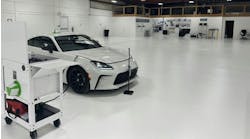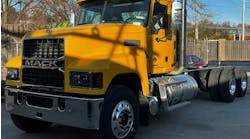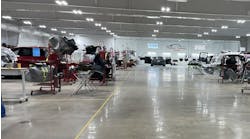This is more likely to happen now than it was 25 years ago because people are more litigious. They understand that they have a right and a responsibility to protect their property, and if it takes the legal system to get the job done, then so be it.
There is no substitute for proper repairs and no excuses for improper repairs in the legal system. You can buy insurance coverage to assist you in a repair that involves a mistake or an unfortunate oversight, but you cannot insure against fraud. Fraud is defined as an intentional misrepresentation of the repair; in other words, you said you would do something in writing, (an estimate), but did something else.
How can you answer the questions about a single repair from 18 months ago? There is no substitute for documentation. Let's begin by assuming you have little or no documentation on this particular repair. Your senior technician completed the repairs, and when confronted with the question of procedure, he cannot remember that particular vehicle because he has repaired a couple of hundred vehicles since that one went through the shop.
If this winds up in court and your senior tech is grilled about specific repairs, pleading the fifth or saying "I don't remember" is not going to put you in a favorable position. You can be assured that the attorney has done his homework, and although he is not versed in collision repair he has paid a subject matter expert to guide him in the correct questioning techniques.
The point here is that things will go badly in court for you if there are no records on this repair, other than the original estimate and maybe some parts receipts. Without proper documentation, the technician is forced to rely on memory, and that will not go well for him or the shop owner through the course of the trial.
It would be much better for the shop and the technician if a complete file with proper records were kept on this vehicle and all vehicles repaired. This record system might include the following information before repairs ever begin: work order with customer signature, original estimate with photos, parts order list with the parts person's name, delivery date of completed parts order, start date of repairs, technician's name and anyone else assigned to the vehicle, printout of damaged structural alignment specifications, diagram of suspension parts with fasteners and attachments, torque specs for suspension parts and any mechanical operations, wiring diagram for any electrical or electronic repairs, printout of dash lamp code information, troubleshooting flowcharts, any repair precautions for work being performed, any manufacturer recall information, paint code, formula and variant information, any repair or refinish history, wheel alignment specifications and torque specifications for the wheels.
All of this information will become a part of the permanent file on the completed vehicle.
Mike Dickes is the quality control manager at Impact Auto Body in Mesa, Ariz. His duty includes a review of the original estimate with any supplements and a complete line-by-line audit of the job after repairs are completed.
"The process of auditing the estimate insures that the vehicle has been repaired properly and as it was written," Dickes says. "Any change in the repair plan along with customer contact information and approval will be reflected in the final estimate or supplement documentation. The issue of fraud is avoided by making sure that the paperwork documentation is current and correct. Part of what I am looking for is the quality of the work as well as the accuracy of the repair documents." The completed file will include an original estimate, any supplements, parts order forms, receipts for parts and repair documentation.
"It is important to monitor the repair process as it occurs, simply because decisions can be made by the repair technician and management that sometimes make perfect sense, but this change in the repair plan must be noted and approved by the customer to avoid any misunderstandings after the repairs are finished and the final billing is complete," Dickes says. "This process is not difficult, but is essential to a successful outcome with the customer."
Dominic Stratman is a seasoned veteran technician at Bort's Auto Body in South Sioux City, Neb. He adds some insight from a technician's point of view. "We feel that we are second to none when it comes to quality repairs. I review the damage report with the owner as work begins and refer back to the report as a repair plan progresses. Any changes in the repair plan are a matter of conference with the management and the customer, as well as the insurance company if there is a claim involved. Most of our work is insurance related, so this calls for good communication with everyone involved. One of the frustrations is, and probably always will be, when the customer asks us to do something that is not recommended or approved by the vehicle manufacturer. In most cases the customer does not understand the engineering process and how a repaired rail reacts to a second collision as opposed to the same rail being replaced as per specifications. We are then faced with a repair by economics rather than correct and safe repair procedures that we can be proud of. We would rather turn this type of work away and concentrate on our quality and loyal customer base.
"We have continued our policy of training and keeping up with repair trends," Stratman continues. "We attend I-CAR classes regularly and put those practices into our daily work routine. As far as documentation, we strive to make sure each vehicle file is complete and accurate and reflects exactly what has been done to the vehicle. Those records are filed, should we ever have to go back and revisit a repair order."
One lesson that can be learned comes from the insurance industry. They record everything that goes on in relation to a claim. Vehicle information and condition is documented. Photos are taken. Financial information for proper issuance of claim payment is recorded. One of the most powerful tools is the simplest: a time/date log. Every transaction that takes place, no matter how insignificant it seems, needs to be recorded. Track who called whom and on what date and time and what was said and what was the outcome of the conversation.
This type of recorded documentation is powerful when questions come up about what was agreed on and by whom. In one instance, a car rental representative wanted the rental car returned by a specific date. The repair time that was listed on the estimate by the insurer was an unreasonable amount of time for the repair and there was an issue of parts being backordered. The highlights from a phone call from the rental agent was written and recorded in a time/date log and the shop representative explained why the vehicle could not be delivered in the time frame specified by the insurer. The name of the representative also was recorded along with the time of day and the date on which the conversation occurred. The result of this documentation allowed several more days of repair time. And because the representative's name and time and date were recorded, a misunderstanding was avoided and the customer kept the rental car until the job was completed.
Another good lesson is one that is implemented by many shops. The estimator or shop manager gives his technicians as much information about the repair as possible. When he assigns a job to a technician, the following information file is placed in or on the vehicle or physically handed to the technician. The information cuts down on the time a technician has to spend researching all of the related information. This process not only helps with liability later on, but immediately impacts production by speeding up the process of repair because the technician does not have to look up technical data, but concentrates on the process of repairing the vehicle.
Depending on the type of damage that is done to the vehicle, this information folder should include as much technical information as possible, including a communication log, arrival time, mileage, malfunction indicator lamps and diagnostic trouble codes and critical information on the vehicle, parts order date and arrival time, work order and estimate number, repair start date, technician's name or number, estimate/supplements, frame structural specs, sectioning procedures, wiring diagrams, FEA specs, torque specs, paint formula and any prior information on the paint/color, material or parts that are specific to the vehicle, wire harness repair specs, fluid requirements and adhesive requirements.
Most of this information can be gathered from a single source such as a supplier of collision related data, along with the help and assistance from the front office. The role and scope of the estimator, manager or quality control specialist just may have increased. If we can lessen the information gathering of the repair staff and allow them to concentrate on repairing vehicles, that's a win/win situation.
The automobile repair industry is involved in a great deal of courtroom litigation. Much of the collision industry has not done the best job of protecting itself with documentation. Going to court to defend a repair is no fun, and it's extremely expensive, even if you win.
The collision repair industry has several formidable challenges. Vehicles have become more complex to repair, training programs are needed, there's a constant push to hurry the repair, a shortage of qualified technicians and slimmer profit margins are a few of the challenges that most shops face. Documentation may not be an answer to all of these issues, but if it can keep you out of the courtroom and in production, which is a huge step in the right direction.
Author's note: Keith Schieffer is a technical team leader and instructor at Universal Technical Institute's Collision Repair and Refinish Technology program in Houston, Texas.



